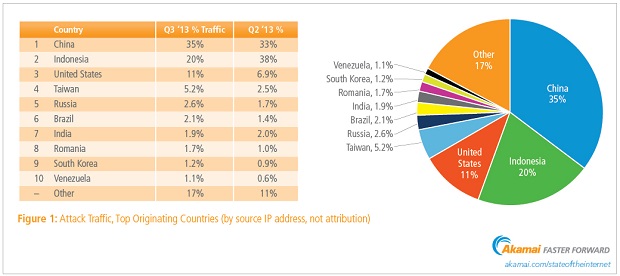Akamai study shows growth in broadband speeds

The new Akamai report on The State of the Internet, for the 3rd quarter of 2013 is out. It shows a small decrease in the number of DDOS attacks observed, a large increase in average broadband bandwidth and continued large increases in mobile data consumption.
Akamai's content delivery network (CDN) consists of servers close to users around the world, putting the company in a unique position to observe network and user behavior.
The report regularly tracks malicious traffic on the network. For several quarters, Indonesia had been the leading source country for such traffic, but in the 3rd quarter the lead shifted back to China, the traditional leader.

Another change back to traditional behavior can be seen in the top TCP ports used for attacks. Number 1 in this report at 23 percent is, once again, 445 (Microsoft-DS). The difference was made up with a decrease in attacks on ports 80 (HTTP) and 443 (HTTPS/SSL).
Overall, DDOS attack traffic declined in the quarter from 318 to 281 attacks. This is the first time Akamai has observed a quarterly decrease in DDOS attacks since they began reporting on them. In spite of this, the overall trend is still sharply up, and more attacks have been observed in the first three quarters of 2013 than in all of 2012.
Akamai also tracks bandwidth speeds in their report. The 3rd quarter showed a 10 percent increase in global average connection speed. Akamai detected strong increases in speed in many countries, but nowhere else as much as in South Korea where bandwidth went up 66 percent.
The report tracks mobile data bandwidth and consumption as separate measures, and here the results are what you might expect: growing like crazy.
Many other categories of data are covered in the report, especially comparing geographic regions.